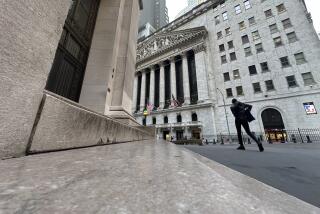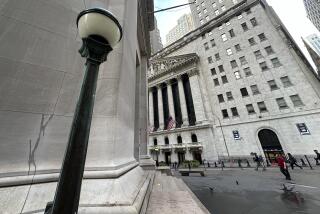Stability Draws Foreign Money to U.S. Markets
What’s encouraging the stock market? Although stock prices declined broadly Tuesday, the market has been very strong in the past week and a half, lifting the Dow Jones industrial average to new post-crash highs. And many experts see a basically rising market, with occasional short-term dips, continuing into next year.
What’s behind it? Lots of things, including Chinese students in Tian An Men Square demanding democracy and shouting the names of Jefferson and Lincoln. Their apparently successful challenge to established government is frightening some people, particularly in Asia, and causing them to look for safety by investing in U.S. stocks and bonds.
Money is funny that way: Most people cheer Beijing students shouting Jefferson and Lincoln. But money people in Hong Kong and elsewhere often see unrest and so send cash to the safety of the politically stable United States--perhaps not even making the connection that it is because of the democracy of Jefferson and Lincoln that the country is a politically stable place for money.
But foreign buying isn’t the only reason for the market’s strength.
The outlook for inflation is good. Prices of industrial commodities are falling, consumers are spending less and saving more--U.S. personal savings rates are rising--notes Charles Clough, investment strategist for Merrill Lynch & Co. That means more domestic savings is available to finance government budget deficits, so less foreign capital will be needed--and ultimately the Federal Reserve can ease up on interest rates.
And individual investors have been returning to the stock market, showing enthusiasm for the first time since the October, 1987, crash. In a global market where all the talk is of institutions throwing around billions, the individual investor tends to get lost. But individual share owners are huge in number and powerful in effect--without them the market is dull and lacks a deep reservoir of buyers and sellers, as it has for the past year.
In August, 1987, at the peak of the bull market when the Dow Jones average topped 2700, there were 53 million individual share owners, according to Sindlinger & Co. of Wallingford, Pa., which keeps such figures. As of last November, their numbers had dwindled to 33 million, but since then they have come back slowly--today there are 47 million individual share owners. And many have become active in the last few weeks.
“We’re having our busiest month since the crash,” says Thomas Quick, vice president of Quick & Reilly, the discount brokerage firm. Individual investors “have seen blue chip stocks going up four and five points and have come into the market,” explains Quick. “After all, what’s the downside risk?”
Actually, there’s plenty of risk. In the crash, even the biggest companies lost almost a third of their value. That led investors to quit the stock market as they had only once before in the postwar period, after the market’s decline in 1970. Otherwise the number of individual share owners in the United States has risen steadily from 6.5 million in 1952--just about the time a marketing-minded head of the New York Stock Exchange named G. Keith Funston began attracting investors with the slogan, “Own your own share of American business.”
Yes, but, with the market averages rising sharply, are individuals tempting fate by investing again? No, say the pros, today’s conditions are different from the time of the crash. There’s no speculation and new issues markets are quiet, notes Robert Farrell, market strategist of Merrill Lynch.
And relative prices are much lower. At the crash, stock prices were close to 20 times the average company’s earnings--a point reached only five times in more than 100 years of stock market action, according to “Wall Street Waltz,” a book by San Francisco investment adviser Kenneth Fisher. Most of the time, the market’s average price-earnings ratio is a little below 15, and stocks begin to look cheap at PE ratios of 13. Today, with corporate profits having grown, the market’s average PE is 12.
And there’s cash in mutual funds and pension funds available for investment, says market analyst Elaine Garzarelli of Shearson Lehman Hutton. She sees inflation staying below 4.5% and the next two years being good for stocks.
She is not alone. Nomura Securities, Japan’s largest brokerage firm, recently told a meeting of its international representatives that U.S. equities are the buys right now--the first time since the crash that Nomura has been bullish on the U.S. market.
Which means more foreign investment. That trend will grow as more of the world’s people are allowed to invest in U.S. stocks and bonds, says John Hennessy, vice chairman of CS First Boston, an international investment bank. As recently as 1979, explains Hennessy, government restrictions in most countries kept investments within national borders. But as such laws are relaxed, more people are free to invest their money wherever they wish--with first choice, by far, the politically stable United States.
More to Read
Inside the business of entertainment
The Wide Shot brings you news, analysis and insights on everything from streaming wars to production — and what it all means for the future.
You may occasionally receive promotional content from the Los Angeles Times.










